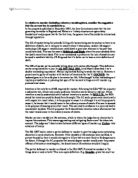Factual causation: the defendant can only be found guilty if the consequence would not have happened ‘but for’ his act.
This was seen in the case of White 1910.
Legal Facts: Defendant put cyanide into his mother's lemonade drink, but she died of heart failure before the poison could kill her. The answer to the question 'But for what the defendant did would she have died?' is 'No'. She would have died anyway.
Judicial Principle: Therefore the defendant was acquitted of murder because he did not cause his mother death as there was no factual cause of the death because the actual cause was natural and not affected by the defendants act
The principle can also be seen in an unusual way. This was seen in the case of Pagett 1983.
Legal Facts: Defendant armed with a shotgun and cartridges, shot at police who were attempting to arrest him. Defendant held a 16-year-old girl who was pregnant by him as a shield. The officers returned fire and the girl was killed.
Judicial Principle: The jury acquitted him of murder and convicted him of manslaughter. His unlawful and dangerous act was the cause of Gail's death, and that was sufficient as she would not have died ’but for’ his use of her as a human shield.
Legal Causation : once it is established that there is factual causation , the persecution must also prove legal causation. This is the operating and substantial cause’ test to find the link between the defendants act and the criminal consequence.
Name of Case: Jordan 1956
Legal Facts: Defendant stabbed victim, who was taken to hospital, a week later the wound was almost healed, doctors gave him incorrect injection and he died.
Judicial principle: the medical treatment was ‘palpably wrong’ and would not have ‘precluded’ a jury from holding that death which was caused by the defendants action.
Name of Case: Smith 1959
Legal Facts: Defendant stabbed Victim, which cause the victim to have a pierced lung. At the first aid post the medical officer was busy and took some time to get the victim that died about an hour after the stabbing.
Judicial principle: the treatment he was given was thoroughly bad and might well have affected his chances of recovery, but medical treatment correct or not correct does not break the chain of causation, at the time of the death the original wound was still an operating cause and a substantial cause, then the death can be said to be a result of the wound that some other cause is also operating.
Name of Case: Chesire 1991
legal Facts: Defendant shot victim and victim was taken to hospital where a tracheotomy was performed, 6 weeks later the victim suffered breathing problems because of the tracheotomy scar and died. The hospital had been negligent perhaps even reckless.
Judicial principle: It was discovered that his windpipe had narrowed and this caused the severe breathing difficulties that he was experiencing at the time of his death. It was argued that this was due to the negligence of the hospital when the tracheotomy tube was fitted and this, therefore, had broken the chain of causation. The trial judge directed that a non act intervenens would only have occurred if the doctors had acted recklessly. Thus, the defendant was found guilty,
Name of Case: Malcherek 1981
Legal Facts: Defendant stabbed his wife who was taken to hospital and put on a life machine. She suffered two heart failures and after 10 days she irretrievable brain damage, the doctors then decided to switch of the machine.
Judicial Principle: the doctors did not break the chain of causation as the defendants act could be regarded as the cause of the victims death.
Name of Case: Blaue 1975
Legal Facts: Defendant stabbed an 18 year old women and punctured her lung. At the hospital, the victim was told she would need a blood transfusion to save her life. But refused this as contrary to her religious beliefs. She died the nest day.
Judicial Principle: the defendant must take the victim as they find them, meaning not just her physical condition but also her religious beliefs. The question for the court was what caused her death. The answer was the stab wound; therefore the defendant caused the death of the victim.
Name of Case: Roberts 1971
Legal Facts: defendant was in a car with a victim who was the passenger in the defendants car she injured herself by jumping out the car as she claimed that the defendant sexually attacked her.
Judicial Principle: it was held that ‘Occasioning’ in ABH relates to causation and is an objective test. If the common assault was intentional there is no need to consider recklessness. The proper test for ‘occasioning’ is not whether the defendant actually foresaw the conduct of the victim which resulted in the actual bodily harm, but whether that conduct could have reasonable foresee as the consequence of what he was doing or saying.
Name Of Case: Williams 1992
Legal Facts: Defendant picked up a hitchhiker who was the victim and allegedly tried to rob him. The victim jumped from the car at about 30mph, and suffered head injuries from which he died.
Judicial Principle: the victims own act might be unreasonable and so break the chain of causation. Therefore the victim caused its own injuries.
The Homicide Act 1957, S3
Yes No
Subjective Test: Objective Test:
No
Yes Yes
Voluntary manslaughter: Diminished responsibility:
http://sixthformlaw.info/02_cases/mod3a/cases_34_vol_provocation.htm#Bedder,%20R%20v%20%281954%29%20HL







